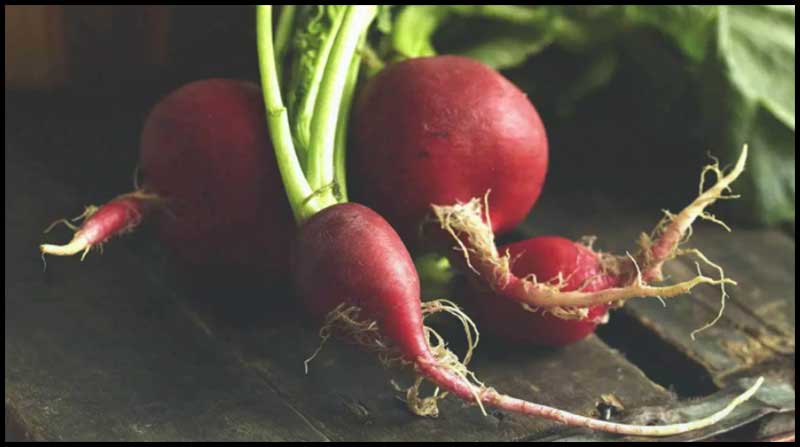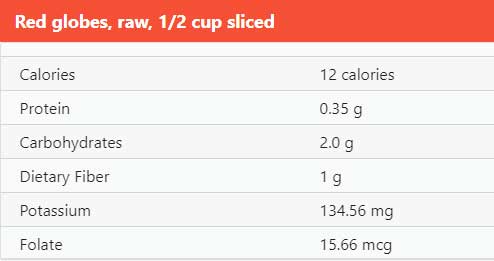Radishes may not be the most popular vegetable in your garden, but they are one of the healthiest.
These undervalued root vegetables are packed with nutrients. They may even help or prevent some health conditions.
5 Health Benefits of Radishes
Radishes are not well-studied for conventional medicinal use. Most studies have been done on animals, not humans. Even so, radishes have been used as a folk remedy for centuries. They are used in Ayurveda and Traditional Chinese Medicine to treat many conditions such as fever, sore throat, bile disorders, and inflammation.
Radishes may offer these additional health benefits.
1. They Won’t Derail Your Healthy Eating Plan
A 1/2-cup serving of sliced radishes contains about 12 calories and virtually no fat, so they won’t sabotage your healthy diet. They are the perfect crunchy snack when the munchies strike.
Radishes are a good source of vitamin C. Just 1/2 cup offers about 14 percent of your recommended daily allowance. Vitamin C is an antioxidant that helps battle free radicals in your body and helps prevent cell damage caused by aging, an unhealthy lifestyle, and environmental toxins. Vitamin C also plays a key role in collagen production, which supports healthy skin and blood vessels.
Radishes contain small amounts of:
- potassium
- folate
- riboflavin
- niacin
- vitamin B-6
- vitamin K
- calcium
- magnesium
- zinc
- phosphorous
- copper
- manganese
- sodium
2. Anticancer Properties
Eating cruciferous vegetables like radishes may help prevent cancer. According to the Linus Pauling Institute, cruciferous vegetables contain compounds that are broken down into isothiocyanates when combined with water. Isothiocyanates help purge the body of cancer-causing substances and prevent tumor development.
A 2010 study found that radish root extract contained several types of isothiocyanates that caused cell death in some cancer cell lines.
3. Support A Healthy Digestive System
A 1/2-cup serving of radishes gives you 1 gram of fiber. Eating a couple servings each day helps you reach your daily fiber intake goal. Fiber helps prevent constipation by bulking up your stool to help waste move through your intestines. Fiber also may help you manage blood sugar levels, and has been linked to weight loss and lower cholesterol.
Radish leaves may be especially beneficial. Results of a 2008 study on rats fed a high-cholesterol diet suggest that radish leaves are a good source of fiber to help improve digestive function. This may be partially due to increased bile production.
A separate study showed that radish juice may help prevent gastric ulcers by protecting gastric tissue and strengthening the mucosal barrier. The mucosal barrier helps protect your stomach and intestines against unfriendly microorganisms and damaging toxins that may cause ulcers and inflammation.
4. Antifungal Properties
Radishes are a natural antifungal. They contain the antifungal protein RsAFP2. One study found RsAFP2 caused cell death in Candida albicans, a common fungus normally found in humans. When Candida albicans overgrows, it may cause vaginal yeast infections, oral yeast infections (thrush), and invasive candidiasis.
An earlier study in mice showed that RsAFP2 was not only effective against Candida albicans, but also other Candida species to a lesser degree. RsAFP2 was not effective against Candida glabrata strains.
5. Help Reduce Zen Effects
Zearalenone (zen) is a toxic fungus that invades many corn crops and animal feeds. It has been linked to reproductive problems in animals and humans, although the risk to humans is considered small. According to a 2008 study, radish extract improved the antioxidant level in mice and can be considered a safe way to diminish or prevent zen effects.
Nutrition Facts
Learn more about the nutritional value of eating raw radishes.
What Are Radishes?
Radishes are root vegetables from the Brassica family. Close relatives of the radish include:
- broccoli
- mustard greens
- kale
- cauliflower
- cabbage
- turnips
Radish bulbs, also called globes, come in many shapes and colors. The most popular radish variety in the United States is bright red and resembles a Ping-Pong ball with a small tail. Other varieties are white, purple, or black. They may be larger and oblong in shape.
Most radishes have a peppery taste, although some may be sweet. Lighter-colored varieties like the white, winter daikon radish have a milder taste. Radishes become overly pungent if they are left in the ground too long or not eaten right away. Smaller radishes tend to have the best flavor and texture.
Delicious Ways To Use Radishes
Don’t limit yourself to only using radishes in salads. Think outside the box! The zesty flavor of radishes lends itself well to many recipes. Here are some ways to incorporate radishes into your diet:
- Add thin radish slices to sandwiches.
- Make a radish dip by pulsing 1/2 cup of Greek yogurt, 1/4 cup chopped radishes, one minced garlic clove, and a splash of red wine vinegar in a food processor until smooth.
- Add a few grated radishes to your favorite slaw.
- Give tuna salad or chicken salad pep and crunch by adding 1 to 2 teaspoons of chopped radishes.
- Coarsely chopped radishes give tacos zesty crunch.
- Top your steak or burger with grilled radish slices.
- Use radishes as a healthy crudité for dips.
- Pickle them like you would cucumbers.
When preparing radishes, don’t toss the green parts. Radish greens are delicious and healthy. They are flavorful in salads or sautéed in a bit of olive oil and garlic. You can also mix them with other greens such as mustard greens, turnip greens, kale, and spinach.
The Takeaway
Radishes are good for you. They’re generally safe to eat, but don’t go overboard if you have thyroid problems.
Excessive amounts may interfere with thyroid hormone production. A study on ratsTrusted Source found that chronic radish consumption increased the weight of the thyroid gland and decreased thyroid hormone levels. This mimicked a hypoactive thyroid condition even after iodine supplementation. Since radishes may increase bile production, don’t eat them without your doctor’s approval if you have gallstones.
The next time you’re strolling through the produce section of your grocery store, don’t let radishes be an afterthought. You may not be able to consume enough to fulfill your recommended intake of all nutrients, but adding a serving or two to your diet each day gives you a healthy dose of beneficial nutrients and disease-fighting compounds.
Sources:
· Alqasoumi, S., Al-Yahya, M., Al-Howiriny, T., & Rafatullah, S. (2008). Gastroprotective effect of radish “raphanus sativus” L. on experimental gastric ulcer models in rats. Farmacia, LVI(2), 204-214
faculty.ksu.edu.sa/rafatullah/Old/PBL_036.pdf
· Beevi, S. S., Mangamoori, L. N., Subathra, M., & Edula, J. R. (2010, September). Hexane extract of Raphanus sativus L. roots inhibits cell proliferation and induces apoptosis in human cancer cells by modulating genes related to apoptotic pathway. Plant Foods for Human Nutrition, 65(3), 200-209
link.springer.com/article/10.1007%2Fs11130-010-0178-0
· Bowen, R. (2001, November 4). The gastrointestinal barrier
· Candidiasis. (2015, June 12)
cdc.gov/fungal/diseases/candidiasis/
· Chandra, A. K., Mukhopadhyay, S., Ghosh, D., & Tripathy, S. (2006, August). Effect of radish (Raphanus sativus Linn.) on thyroid status under conditions of varying iodine intakes in rats. Indian Journal of Experimental Biology, 44(8), 653-661
ncbi.nlm.nih.gov/pubmed/16924836
· Higdon, J. (2008, November). Isothiocyanates
lpi.oregonstate.edu/mic/dietary-factors/phytochemicals/isothiocyanates#table-2
· Jang, H. S., Ahn, J. M., Ku, K. H., Rhee, S. J., Kang, S. K., & Choi, J. H. (2008). Effect of radish leaves powder on the gastrointestinal function and fecal triglyceride, and sterol excretion in rats fed a hypercholesterolemic diet. Journal of the Korean Society of Food Science and Nutrition, 37(10), 1258-1263
agris.fao.org/agris-search/search.do?recordID=KR2009001541
· Mayo Clinic Staff. (2015, September 22). Dietary fiber: Essential for a healthy diet
mayoclinic.org/healthy-lifestyle/nutrition-and-healthy-eating/in-depth/fiber/art-20043983
· Radish. (n.d.)
extension.illinois.edu/veggies/radish.cfm
· Salah-Abbes, J.B., Abbes, S. Ouanes, Z., Houas, Z., Abdel-Wahhab, M.A., Bacha, H., & Oueslati, R. (2008, January). Tunisian radish extract (Raphanus sativus) enhances the antioxidant status and protects against oxidative stress induced by zearalenone in Balb/c mice. Journal of Applied Toxicology, 28(1)
onlinelibrary.wiley.com/doi/10.1002/jat.1240/abstract
· Tavares, P. M., Thevissen, K., Cammue, B. P. A., Francois, I. E. J. A., Barreto-Bergter, E., Taborda, C. P., … & Nimrichter, L. (2008, December). In vitro activity of the antifungal plant defensing RsAFP2 against Candida isolates and its in vivo efficacy in prophylactic murine models of candidiasis. Antimicrobial agents and chemotherapy, 52(12), 4522-4525
aac.asm.org/content/52/12/4522.full
· Thevissen, K., de Mello Tavares, P., Xu, D., Blankenship, J., Vandenbosch, D., Idkowiak-Baldys, J., … & Cammue, B. P. A. (2012, April). The plant defensing RsAFP2 induces cell wall stress, septin mislocalization and accumulation of ceramides in Candida albicans. Molecular Microbiology, 84(1), 166-180
onlinelibrary.wiley.com/doi/10.1111/j.1365-2958.2012.08017.x/abstract
· Zinedine, A., Soriano, J. M., Molto, J. C., & Manes, J. (2007, January). Review on the toxicity, occurrence, metabolism, detoxification, regulations and intake of zearalenone: An oestrogenic mycotoxin. Food and Chemical Toxicology, 45(1), 1-18
sciencedirect.com/science/article/pii/S0278691506002432
Important Notice: This article was originally published at www.healthline.com by Annette McDermott where all credits are due. Medically reviewed by Natalie Butler, R.D., L.D.










